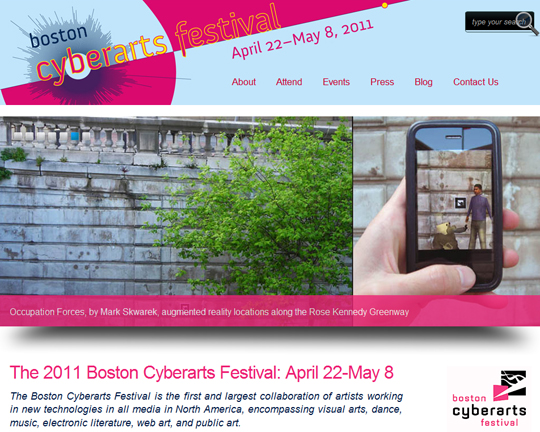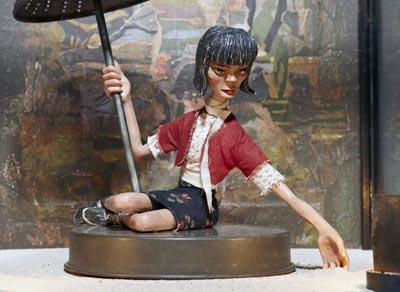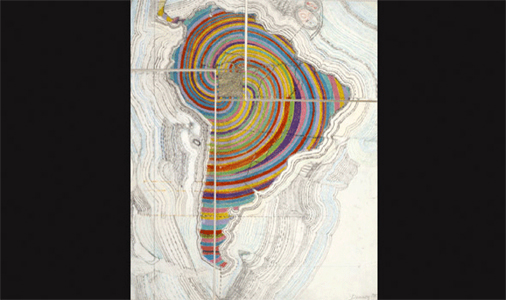Premiered by George Fifield in 1999, the Boston Cyberarts Festival was launched with generous seed funding from the Massachusetts Cultural Council. The biennial event is the only festival in the world inclusive to all art forms--both visual and performing, film, video, electronic, literature, public art and web art.

Boston Cyberarts Festival screenshot
The 7th Annual Boston Cyberarts Festival occurs April 22 - May 8, 2011, and with so many happenings coming together as a single occasion there is much to hear and see, like the work of the Urbano Project, an organization run thought MIT's Urban Arts Institute. Heidi Kayser, who is an artist-in-resident and youth programmer for the Urbano Project says that "Urbano's mission is to facilitate public art in public spaces."
"In achieving this, the youth involved of all ages have 5 different programs they can be a part of," she says.
The Axiom Center for New Experimental Media presenting an exhibition curated by Kayser entitled Move Me: An exhibition of Contemporary Kinetic Sculpture. Brandeis University will also have a presence at this year's festival, presenting the "BEAMS Electonic Music Marathon," which features electronic and computer sounds by an international roster of musicians and composers on April 30th from noon till midnight.

"Dreamtime" by Tom Haney (Image: Tom Haney and Boston Cyberarts)
Having a focus on digital art, this year more than 50 events and exhibitions will be showcased. An excerpt from a recent press release reads:
CyberartsCentral, the 2011 Boston Cyberarts Festival headquarters located at Atlantic Wharf, will feature exhibitions, music and dance performances, augmented reality, and real-time rendered audiovisual demonstrations...
Speaking to some of the audio/visual events, like "The Get Together" and "Cyber-Pool," which combines installations and performances. Fifield says, "One of the distinctive features of the Boston Cyberarts Festival has always been its inclusiveness... from the beginning we have sought out events and exhibitions in all art forms, including not just visual art but a variety of performing arts as well."
In an special interview, Fifield shared more of his thoughts on this year's line-up of events.
Max Eternity (ME): George, there's one event that I want to ask about first, The Egyptian Oracle.
George Fifield (GF): The Egyptian Oracle - it's a virtual reality project, which will be an archaeological accurate moment in Egypt, with an Egyptian high priest avatar controlled by an engineer. The audience can interact, asking questions.
Virtual reality is different from augmented reality. The institute of Contemporary art is going to be filled with augmented reality art. So it's like this, when you put virtuality in real space, you can look at that real space through your smart phone, for instance, and the augmented reality will show up. Manifest.art is doing this project.
ME: Could you talk about what Greenway Conservancy is doing?
GF: The Greenway Conservancy is on blocks of what's being called "occupation forces"... little signs and symbols. You will see standing around the symbols, little tiny spacemen that have taken over the planet, but nobody knows it because they are invisible.
ME: That's curious. And there's also a Festival of Art, Science and Technology.
GF: Yes. This year's festival coincides with the 150th anniversary of MIT. They are doing a conference on dance and technology, and the other [event] is a daylong event with Autopinie--the founder of sky art. He's doing one of his sky art sculptures.
At the List Visual Art center is Juan Downey.

"America is Back Together" by Juan Downey (Photo: Marilys Belt Downey)
ME: Wow, that sounds really interesting. And finally, tell me about the show you curated, "Drawing with Code: Works from the Anne and Michael Spalter Collection"?
GF: I used to be curator of new media there for 13 years. I met this couple who lives in Providence, collecting this work for the last 17 or 18 years; focusing on the early days--graphic prints from people who were working on mainframes and punch cards. This was the time when you said your work was made on the computer. But then, people said if the computer is doing it, then who are you?
Manfred Mohr, Frieder Nake, Daniele Laposky and Ken Nolton were some of those people in the 1950's.
This show is one of a number of shows that talks about our history, because It's important to have some discussion about the history. The Goethe institute is showing a collection of early German art.
ME: I do think it's important to tell some of these historic back stories, especially when talking about how digital and new media arrived in its present state.
GF: This idea of balancing the most cutting-edge, with history, is always important to me.
The art world is finally paying attention to these pioneers. Computers were thought of as so differently back then.
ME: Sure, so much has changed. George, thank you for your time.
GF: Any time, Max, thank you.